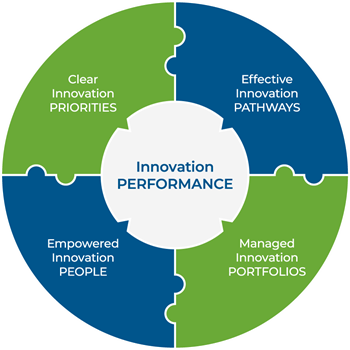In Brief
Organizations invest enormous resources to strengthen their capabilities and capacity to innovate but are often disappointed by the results. Organizations can avoid many of the potential traps by taking a systems lens rather than focusing on point solutions.
Companies trying to strengthen their innovation capabilities frequently take steps to establish budgets, build teams or take other logical steps toward an enterprise system approach. Still, many of these initiatives fail. Incubators or new-growth teams frequently stumble because the connection between their innovation priorities and the broader enterprise strategy is unclear or because the process, metrics, funding mechanisms and people involved are better suited to the near-term needs of the core business than to longer-term, more transformational opportunities. Corporate venture capital or innovation funds disappoint because leaders, in the absence of appropriate goals and metrics for success, apply pressure for traditional financial results. Innovation training or coaching programs leave participants with new skills and tools that are simply impractical to use in their daily work because of management resistance or lack of integration with broader company processes. Lean startup sprints hit a brick wall when promising ideas attempt to transition to a business unit (BU) where they can be resourced and scaled. The appointment of a “chief innovation officer” to the corporate center (outside of the profits and losses) leads to organizational confusion around where the decision-making power really sits to resource innovation.
The problem is not that these interventions are intrinsically bad ideas. Each can play an important role, but problems arise when they are implemented without full consideration of the broader set of enablers that must be in place for any individual initiative to be successful. In other words, building an innovation capability is a systems design challenge that requires a system solution; if instead you try to build it by cobbling together isolated point solutions, each is likely to fail in entirely predictable ways.
The innovation performance model — which describes the five primary components of a complete innovation system — can be used to map an organization’s current approach to innovation, assess what’s working well and identify areas for improvement. This, in turn, can help leaders to strengthen their own systems for innovation, building on the foundations already in place.
Innovation Performance
Innovation should always be a means to an end, not an end in itself. These goals will vary from one organization to the next, but defining them clearly is a precursor to building the right capability and being able to measure its effectiveness. Regardless of the specific metrics tracked, teams must be careful to focus on the few that matter and avoid the twin traps of metric proliferation (tracking too many metrics simultaneously) and vanity metrics (tracking easily achievable measures that deliver a false sense of progress).
An organization must clarify and align on two types of performance for innovation:
Clear Innovation Priorities
Once innovation performance has been clearly defined, the next step is to clarify the organization’s innovation priorities. Placing constraints on innovation might seem counterintuitive, and indeed there has always existed a natural tension between innovation and focus; one seeks to go beyond boundaries, the other to establish them. Tuning this tension to the right level is the key to innovation productivity.
Managers often assert they do not want to constrain their innovation teams. However, the highest-performing teams are those that are given “just enough focus” to ensure they work on the most valuable ideas, while still giving them ample flexibility to explore creative new approaches to achieving that impact.
Effective Innovation Pathways
An innovation pathway is the set of steps an innovation takes from initial idea to implementation. Innovation pathways exist in all organizations and can be formal, informal or somewhere in between. The key is to ensure all pathways are intentional, explicit and optimized to the type of innovation they are intended to produce.
Effective innovation pathways require:
Managed Innovation Portfolios
One of the biggest challenges in a large organization is the need to manage not just individual innovation projects but also the aggregate portfolio of projects. After all, it is this collective set of projects, drawing from the same pool of resources, that together will achieve the organization’s desired performance outcomes. This means leaders need visibility into these portfolios so they can answer management questions about them, strategically balance resources across them and manage them dynamically over time.
Managed innovation portfolios require:
Empowered Innovation People
Most discussions of the human side of innovation focus on the specific skills, mindsets or behaviors individuals need to be innovative or the corresponding features of an innovative culture. These are certainly important to understand, but if an organization fails to implement all the other components of the innovation performance model, even the most talented innovators can experience frustration.
Organizations can sustainably empower their innovation people by investing in:
Strengthening the Innovation System
Every large organization has, at some time, demonstrated its capacity to innovate successfully (or it would never have achieved success). However, in the inevitable and relentless pursuit of growth and efficiency, structures and processes can calcify and shift focus away from customer understanding and toward product or operational excellence. While innovation systems in smaller organizations often revolve around the persona and actions of a single leader, larger organizations must explicitly build and nurture their innovation systems to ensure they remain nimble and adaptive to the ever-changing environment — in short, that they balance the need to both deliver and discover.
Leaders who seek to understand their system today and take steps to strengthen it across the five dimensions of innovation performance are investing in the engine that will help their organizations own the future.

